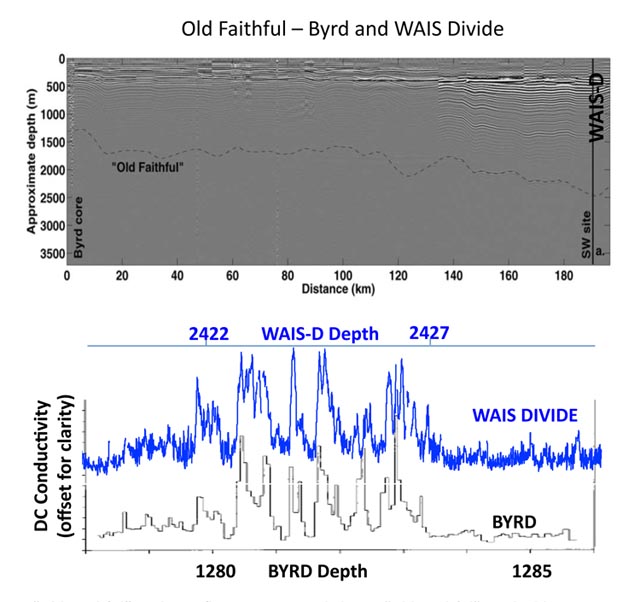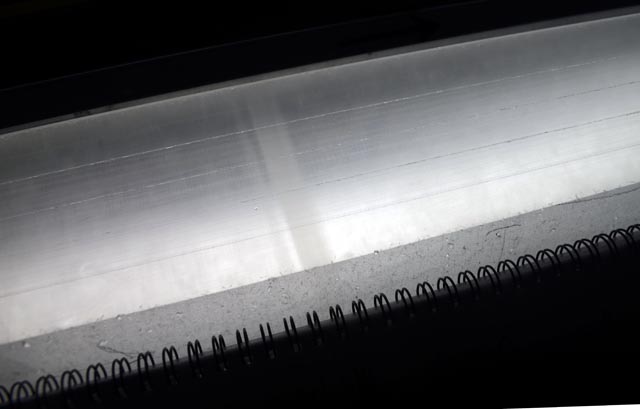|
Faithful reproductionTeam at NICL processes replicate ice cores from WAIS DividePosted June 7, 2013
It’s a scene that’s been repeated for the last several summers in the Denver metro area: People bundled in thick coats, wool hats and heavy boots — as if ready for an arctic adventure — step into what appears to be a white-walled workshop. There are table saws and planers and less familiar instruments, including a device that sports electrodes.
This is the ice core processing room for the National Ice Core Laboratory (NICL)
It reopened for business once again in May to prepare about 280 meters of ice drilled from a lonely, snowy region of West Antarctica for analysis by U.S. scientists studying past climate change.
“The intent is to get the ice to a state where science can be done,” said Don Voigt
The cores are the last to be extracted by the multi-year project known as the West Antarctic Ice Sheet (WAIS) Divide Ice Core project
The eighth and final season of drilling operations in 2012-13 involved using a newly developed drill capable of reentering the original borehole and collecting more ice at specific depths of scientific interest. Specifically, this “replicate” core was drilled at locations where researchers have previously identified abrupt climate changes, when global temperature shifted on a timescale of decades. [See previous article — Repeat experiment: New replicate ice core system will target abrupt climate change events.]
“It’s really exciting that we’re able to hone in on these distinct events and run analyses that you wouldn’t be able to do because you’re limited by the volume of ice,” said T.J. Fudge
The ice core has been described as a sort of time machine that researchers can use to travel back through Earth’s past climate. Scientists can analyze bubbles of various gases trapped in the ice — particularly the important greenhouse gas carbon dioxide — to get a sample of the ancient atmosphere. Dust and chemicals found in the ice can also provide details about past climate and temperature.
Fudge has helped establish the timeline of the ice core, which contains about 68,000 years of climate history. His measurements are also important for matching up the original ice core with the replicate core samples.
So far, so good, in that regard.
“The matching of the depths is absurdly easy,” Fudge said, giving thumbs up to University of Colorado-Boulder
“We’re able to match them up within three centimeters. I’m pretty happy about that. … It’s better than I expected it to be,” Fudge added.
Snow accumulation at WAIS Divide, where the ice begins to flow in different directions (sort of like watersheds along the Continental Divide), is so high that much of the ice contains layers thick enough that scientists can visually identify them as well. It’s only near the bottom where the layers begin to mix and annual resolution is lost.
The replicate core drill, designed and built by Ice Drilling Design and Operations (IDDO)
The depth equates to a time about 38,000 years ago when there was an abrupt warming during the last ice age, also known as the last glacial period. About 600 meters higher — and 20,000 years earlier — than that is an event scientists informally call Old Faithful
Ostensibly referred to as a volcanic layer, there is no real ash associated with the Old Faithful event, according to Voigt.

Photo Credit: WAIS Divide
The Old Faithful event. The top panel shows the layer between ice cores drilled at Byrd and WAIS Divide about 200 kilometers apart. The bottom panel shows electrical conductivity measurements between the two sites.
“It’s just weird chemistry in the ice,” he said, adding that the cocktail of chemicals found along a five-meter-long stretch of ice starting at about 2,422 meters down includes high concentrations of fluoride. Other hypotheses for the high-acidity layer have already been shot down — including meteorites.
“There’s a lot of things it’s not,” Voigt said, explaining there are some indications that the chemistry could still be volcanic in origin but possibly not local.
Old Faithful refers to the persistence of the layer throughout most of West Antarctica. Radar scans of the ice sheet return a bright reflection, always dated to around 18,000 years in other ice cores, except for one drilled at a location known as Siple Dome. The timing of the event coincides with the beginning of the end of the last ice age.
This summer’s CPL was fairly simple compared to previous ones, mainly because the ice is destined for only a few labs. The “cut plan” consisted of two horizontal cuts to produce a surface for ECM and optical observations, and a slender stick of ice for isotope measurements.
“It’s a really beautiful core,” Voigt noted.
The real beauty will come as scientists complete their various analyses of the ice. The WAIS Divide core, thanks to those fat layers of snow, will ease some of the previous uncertainties surrounding the interpretation of the paleoclimate record.
That’s because it takes time before the gas that permeates the snow becomes trapped in the ice. The time lag can take millennia, meaning that the gas bubbles are considerably younger than the surrounding ice. The age difference is far less in the heavily snowed WAIS Divide region — something on the scale of centuries.
Pairing the WAIS Divide ice core with other high-resolution records in Greenland will enable researchers to pinpoint abrupt climate change events within a half-century, according to Fudge.
Science will continue at the WAIS Divide field camp for at least two more austral summers, as a handful of scientists make measurements of the borehole itself. Preparations began last year to tear down the camp, with plans to return equipment and cargo to McMurdo Station
“The measurement period is almost over but the analysis period is only just beginning. There’s going to be exciting results from the WAIS Divide ice core over the next decade,” Fudge said.
For a complete list of all NSF-funded projects related to WAIS Divide, see the WAIS Divide webpage of funded projects
|



For USAP Participants |
For The Public |
For Researchers and EducatorsContact UsU.S. National Science FoundationOffice of Polar Programs Geosciences Directorate 2415 Eisenhower Avenue, Suite W7100 Alexandria, VA 22314 Sign up for the NSF Office of Polar Programs newsletter and events. Feedback Form |




